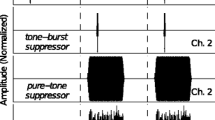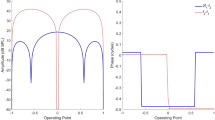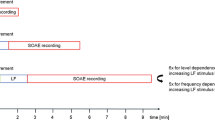Abstract
Intermodulation distortion has been hypothesized as a mechanism contributing to the generation of short-latency (SL) components in the transient-evoked otoacoustic emission (TEOAE). Presumably, nonlinear interactions between the frequency components within the evoking stimulus induce cochlear distortion products, which mix in the cochlea and ear canal with reflected energy from each stimulus-frequency’s tonotopic place. The mixing of these different components is evidenced in the bandpass-filtered emission waveform as a series of different latency peaks. The current study tested the hypothesis that intermodulation distortion, induced within the spectral bandwidth of the evoking stimulus, is the primary mechanism through which the SL components are generated. The nonlinear-derived tone-burst-evoked OAE (TBOAEnl) was evoked using 2-kHz tone bursts with durations of 3, 6, 12, and 24 cycles. As tone burst duration doubled, the spectral bandwidth was halved. It was hypothesized that contributions to the TBOAEnl from SL components would decrease as tone burst duration increased and spectral bandwidth decreased, if the SL components were generated through intermodulation distortion. Despite differences in spectral bandwidth between the evoking stimuli, the latencies and magnitudes of the different latency components between the 3- and 6-cycle TBOAEnl were comparable. The 12- and 24-cycle TBOAEnl envelopes were characteristic of destructive phase interactions between different latency components overlapping in time. The different latency components in the 3- and 6-cycle TBOAEnl introduced a characteristic level dependency to TBOAEnl magnitude and latency when analyzed across a broad time window spanning the different components. A similar dependency described the 12- and 24-cycle TBOAEnl input/output and latency-intensity functions, suggesting that the SL components evident in the shorter-duration TBOAEnl equally contributed to the longer-duration TBOAEnl, despite reductions in spectral bandwidth. The similarity between the different TBOAEnl suggests that they share a common generation mechanism and casts doubt on intermodulation distortion as the generation mechanism of SL TEOAE components in humans.










Similar content being viewed by others
References
Avan P, Bonfils P, Loth D, Elbez M, Erminy M (1995) Transient-evoked otoacoustic emissions and high-frequency acoustic trauma in the guinea pig. J Acoust Soc Am 97:3012–3020
Carvalho S, Büki B, Bonfils P, Avan P (2003) Effect of click intensity on click-evoked otoacoustic emission waveforms: implications for the origin of emissions. Hear Res 175:215–225
Choi Y-S, Lee S-Y, Parham K, Neely ST, Kim DO (2008) Stimulus-frequency otoacoustic emission: measurements in humans and simulations with an active cochlear model. J Acoust Soc Am 123:2651–2669
Don M, Eggermont JJ (1978) Analysis of the click-evoked brainstem potentials in man using high-pass noise masking. J Acoust Soc Am 63:1084–1092
Gilman S, Dirks DD (1986) Acoustics of ear canal measurement of eardrum SPL in simulators. J Acoust Soc Am 80:783–793
Goodman SS, Fitzpatrick DF, Ellison JC, Jesteadt W, Keefe DH (2009) High-frequency click-evoked otoacoustic emissions and behavioral thresholds in humans. J Acoust Soc Am 125:1014–1032
Goodman SS, Mertes IB, Scheperle RA (2011) Delays and growth rates of multiple TEOAE components. In: Shera CA, Olson ES (eds) What fire is in mine ears: progress in auditory biomechanics: Proceedings of the 11th International Mechanics of Hearing Workshop, American Institute of Physics, pp 279–285
Greenwood DD (1961) Critical bandwidth and frequency coordinates of the BM. J Acoust Soc Am 33:1344–1356
Greenwood DD (1990) A cochlear frequency-position function for several species—29 years later. J Acoust Soc Am 87:2592–2605
Guinan JJ Jr (1990) Changes in stimulus frequency otoacoustic emissions produced by two-tone suppression and efferent stimulation in cat. In: Dallos P, Geisler CD, Matthews J, Ruggero MA, Steele C (eds) The mechanics and biophysics of hearing. Springer, Madison, pp 170–177
Hoaglin D, Mosteller F, Tukey JW (1983) Understanding robust and exploratory data analysis. Wiley, New York
Kalluri R, Shera CA (2007a) Near equivalence of human click-evoked and stimulus-frequency otoacoustic emissions. J Acoust Soc Am 121:2097–2110
Kalluri R, Shera CA (2007b) Comparing stimulus-frequency otoacoustic emissions measured by compression, suppression, and spectral smoothing. J Acoust Soc Am 122:3562–3575
Keefe DH (1998) Double-evoked otoacoustic emissions. I. Measurement theory and nonlinear coherence. J Acoust Soc Am 103:3489–3498
Keefe DH, Ling R (1998) Double-evoked otoacoustic emissions. II. Intermittent noise rejection, calibration and ear-canal measurements. J Acoust Soc Am 103:3499–3508
Kemp DT, Ryan S, Bray P (1990) A guide to the effective use of otoacoustic emissions. Ear Hear 11:93–105
Konrad-Martin D, Keefe DH (2003) Time-frequency analyses of transient-evoked stimulus-frequency and distortion-product otoacoustic emissions: testing cochlear model predictions. J Acoust Soc Am 114:2021–2043
Konrad-Martin D, Keefe DH (2005) Transient-evoked stimulus-frequency and distortion-product otoacoustic emissions in normal and impaired ears. J Acoust Soc Am 117:3799–3815
Moleti A, Botti T, Sisto R (2012a) Transient-evoked otoacoustic emission generators in a nonlinear cochlea. J Acoust Soc Am 131:2891–2903
Moleti A, Longo F, Sisto R (2012b) Time-frequency domain filtering of evoked otoacoustic emissions. J Acoust Soc Am 132:2455–2467
Moleti A, Al-Maamury AM, Bertaccini D, Bott T, Sisto R (2013) Generation place of the long- and short-latency components of transient-evoked otoacoustic emissions in a nonlinear cochlear model. J Acoust Soc Am 133:4098–4108
Moleti A, Sisto R, Lucertini M (2014) Experimental evidence for the basal generation place of the short-latency transient-evoked otoacoustic emissions. J Acoust Soc Am 135:2862–2872
Neely ST, Norton SJ, Gorga MP, Jestaedt W (1988) Latency of auditory brain-stem responses and otoacoustic emissions using tone-burst stimuli. J Acoust Soc Am 83:652–656
Prieve BA, Gorga MP, Neely ST (1996) Click- and tone-burst-evoked otoacoustic emissions in normal-hearing and hearing-impaired ears. J Acoust Soc Am 99:3077–3086
Rasetshwane DM, Neely ST (2012) Measurements of wide-band cochlear reflectance in humans. J Assoc Res Otolaryngol 13:591–607
Rasetshwane DM, Argenyi M, Neely ST, Kopun JG, Gorga MP (2013) Latency of tone-burst-evoked auditory brain stem responses and otoacoustic emissions: level, frequency, and rise-time effects. J Acoust Soc Am 133:2803–2817
Recio A, Rich NC, Narayan SS, Ruggero MA (1998) Basilar-membrane responses to clicks at the base of the chinchilla cochlea. J Acoust Soc Am 103:1972–1989
Ren T (2004) Reverse propagation of sound in the gerbil cochlea. Nat Neurosci 7:333–334
Sachs RM, Burkhard MD (1972) Insert earphone pressure response in real ears and couplers. J Acoust Soc Am 52:183
Schairer KS, Fitzpatrick D, Keefe DH (2003) Input-output functions for stimulus-frequency otoacoustic emissions in normal-hearing adult ears. J Acoust Soc Am 114:944–966
Schairer KS, Ellison JC, Fitzpatrick D, Keefe DH (2006) Use of stimulus-frequency otoacoustic emission latency and level to investigate cochlear mechanics in human ears. J Acoust Soc Am 120:901–914
Shera CA, Bergevin C (2012) Obtaining reliable phase-gradient delays from otoacoustic emission data. J Acoust Soc Am 132:927–943
Shera CA, Guinan JJ Jr (1999) Evoked otoacoustic emissions arise by two fundamentally different mechanisms: a taxonomy for mammalian OAEs. J Acoust Soc Am 105:782–798
Shera CA, Guinan JJ Jr (2003) Stimulus-frequency-emission group delay: A test of coherent reflection filtering and a window on cochlear tuning. J Acoust Soc Am 113:2762-2772
Siegel JH, Cerka AJ, Temchin AN, Ruggero MA (2004) Similar two-tone suppression patterns in SFOAEs and the cochlear microphonics indicate comparable spatial summation of underlying generators. Assoc Res Otolaryngol Mid-Winter Meeting Abstract 27:365
Siegel JH, Cerka AJ, Recio-Spinoso A, Temchin AN, van Dijk P, Ruggero MA (2005) Delays of stimulus-frequency otoacoustic emissions and cochlear vibrations contradict the theory of coherent reflection filtering. J Acoust Soc Am 118:2434–2443
Sisto R, Moleti A (2007) Transient evoked otoacoustic emission latency and cochlear tuning at different stimulus levels. J Acoust Soc Am 122:2183–2190
Sisto R, Moleti A, Shera CA (2007) Cochlear reflectivity in transmission-line models and otoacoustic emission characteristic time delays. J Acoust Soc Am 122:3554–3561
Sisto R, Sanjust F, Moleti A (2013) Input/output functions of different-latency components of transient-evoked and stimulus-frequency otoacoustic emissions. J Acoust Soc Am 133:2240–2253
Stinson MR, Shaw EAG, Lawton BW (1982) Estimation of acoustical energy reflectance at the eardrum from measurements of pressure distribution in the human ear canal. J Acoust Soc Am 72:766–773
Stover LJ, Neely ST, Gorga MP (1996) Latency and multiple sources of distortion product otoacoustic emissions. J Acoust Soc Am 99:1016–1024
Talmadge CL, Long GR, Tubis A, Dhar S (1999) Experimental confirmation of the two-source interference model for the fine structure of distortion product otoacoustic emissions. J Acoust Soc Am 105:275–292
Talmadge CL, Tubis A, Long GR, Tong C (2000) Modeling the combined effects of BM nonlinearity and roughness on stimulus frequency otoacoustic emission fine structure. J Acoust Soc Am 108:2911–2932
Tognola G, Grandori F, Ravazzani P (1997) Time-frequency distributions of click-evoked otoacoustic emissions. Hear Res 106:112–122
Tognola G, Ravazzani P, Molini E, Ricci G, Alunni N, Parazzini M, Grandori F (2001) “Linear” and “derived” otoacoustic emissions in newborns: a comparative study. Ear Hear 22:182–190
Verhulst S, Dau T, Shera CA (2012) Nonlinear time-domain cochlear model for transient stimulation and human otoacoustic emission. J Acoust Soc Am 132:3842–3848
Withnell RH, McKinley S (2005) Delay dependence for the origin of the nonlinear derived transient evoked otoacoustic emission. J Acoust Soc Am 117:281–291
Withnell RH, Yates GK (1998) Enhancement of the transient-evoked otoacoustic emission produced by the addition of a pure tone in the guinea pig. J Acoust Soc Am 104:344–349
Withnell RH, Yates GK, Kirk DL (2000) Changes to low-frequency components of the TEOAE following acoustic trauma to the base of the cochlea. Hear Res 139:1–12
Withnell RH, Hazlewood C, Knowlton A (2008) Reconciling the origin of the transient evoked otoacoustic emission in humans. J Acoust Soc Am 123:212–221
Xu L, Probst R, Harris FP, Roede J (1994) Peripheral analysis of frequency in human ears revealed by tone burst evoked otoacoustic emissions. Hear Res 74:173–180
Yates GK, Withnell RH (1999) The role of intermodulation distortion in transient-evoked otoacoustic emissions. Hear Res 136:49–64
Zweig G, Shera CA (1995) The origin of periodicity in the spectrum of evoked otoacoustic emissions. J Acoust Soc Am 98:2018–2047
Acknowledgments
Subject compensation was provided by a grant from the Executive Council for Graduate and Professional Students at the University of Iowa. The authors thank Rachel Stanziola and Brittany James who performed the data collection for this study. Portions of this work were presented at the 2013 Annual Meeting of the American Auditory Society and the 2014 Mid-winter Meeting of the Association for Research in Otolaryngology. This research served as part of the first author’s dissertation work.
Conflict of Interest
Neither of the authors have a commercial interest or other conflict of interest concerning the research detailed in the submitted manuscript. Funds for data collection (subject compensation) were provided by a grant from the Executive Council for Graduate and Professional Students at the University of Iowa.
Author information
Authors and Affiliations
Corresponding author
Rights and permissions
About this article
Cite this article
Lewis, J.D., Goodman, S.S. The Effect of Stimulus Bandwidth on the Nonlinear-Derived Tone-Burst-Evoked Otoacoustic Emission. JARO 15, 915–931 (2014). https://doi.org/10.1007/s10162-014-0484-6
Received:
Accepted:
Published:
Issue Date:
DOI: https://doi.org/10.1007/s10162-014-0484-6




